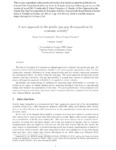A New Approach to the Gender Pay Gap Decomposition by Economic Activity

Use este enlace para citar
http://hdl.handle.net/2183/34463Coleccións
- Investigación (FIC) [1678]
Metadatos
Mostrar o rexistro completo do ítemTítulo
A New Approach to the Gender Pay Gap Decomposition by Economic ActivityData
2022-01Cita bibliográfica
M. J. Lombardía, E. López-Vizcaíno, y C. Rueda, «A New Approach to the Gender Pay Gap Decomposition by Economic Activity», Journal of the Royal Statistical Society Series A: Statistics in Society, vol. 185, n.º 1, pp. 219-245, ene. 2022, doi: 10.1111/rssa.12742.
Resumo
[Abstract]: The aim of this paper is to present an original approach to estimate the gender pay gap (GPG). We propose a model-based decomposition, similar to the most popular approaches, where the first component measures differences in group characteristics and the second component measures the unexplained effect; the latter being the real gap. The novel approach incorporates model selection and bias correction. The pay gap problem in a small area context is considered in this paper, although the approach is flexible to be applied to other contexts. Specifically, the methodology is validated for analysing wage differentials by economic activities in the region of Galicia (Spain) and by analysing simulated data from an experimental design that imitates the generation of real data. The good performance of the proposed estimators is shown in both cases, specifically when compared with those obtained from the widely used Oaxaca–Blinder approach.
Palabras chave
Gender pay gap
Model selection
Nested error regression models
Small area estimation
Oxaca-blinder decomposition
Model selection
Nested error regression models
Small area estimation
Oxaca-blinder decomposition
Descrición
This is a pre-copyedited, author-produced version of an article accepted for publication in Journal of the Royal Statistical Society Series A: Statistics in Society, following peer review. The version of record [M. J. Lombardía, E. López-Vizcaíno, y C. Rueda, «A New Approach to the Gender Pay Gap Decomposition by Economic Activity», Journal of the Royal Statistical Society Series A: Statistics in Society, vol. 185, n.º 1, pp. 219-245, ene. 2022] is available online at: https://doi.org/10.1111/rssa.12742.
Versión do editor
Dereitos
© 2021 Royal Statistical Society
ISSN
1467-985X





